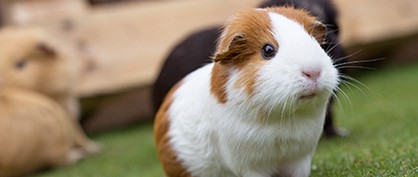How Guinea Pigs Went Global
By Gina Wynn
Ever wonder where the short, squealing furballs we know as guinea pigs came from before they were popular household pets? Researchers from the University of Otago in New Zealand traced the origins of the funny little animals and published their findings in Scientific Reports.
Mini-Mariners
Leaders of the study include Edana Lord (now at Stockholm University, Sweden), Lisa Matisoo-Smith, and Catherine Collins of the Otago Department of Anatomy, along with other international researchers. Using ancient guinea pig DNA from archaeological remains, they were able to map the guinea pig’s transition from food source to domesticated animals to medical test subjects and pets.
The study builds on the work of Matisoo-Smith, a professor of biological anthropology, who investigated human population origins in the Pacific by tracking the movements of settlers. She gathered data by analyzing the DNA of plants and animals they carried in their canoes.
To take this a step further, her team zeroed in on guinea pigs in the Caribbean, hoping to find out where they came from.
Curious Creatures
Considered a rodent, guinea pigs have no tails, weigh 1.5 to 2.5 lbs., and are 8 to 10 inches long. The scientific name of the domesticated guinea pig species we keep as pets is Cavia porcellus.
Known for their diversity in fur coloring, patterns, length, and texture (including trend-setting mohawk, spiked, and shag hairdos), 13 breeds highlight their most distinguishing characteristics: American, American satin, Abyssinian, Abyssinian satin, Peruvian, Peruvian satin, silkie, silkie satin, teddy, teddy satin, texel, coronet, and white crested, according to Animal Diversity Web.
Originally from the Andes region of Peru, guinea pigs were domesticated as an accessible food source. They were also used in folk medicine and religious ceremonies. Then, they were traded around South America, explained Matisoo-Smith in a University of Otago report. Her group found that around AD500, they were also taken to the Caribbean islands through trade networks.
"They were and still are an important food item in many parts of South America and cultures that derived from South America — people took them live to introduce to new islands where they were not native or they traded them for other goods," said Matisoo-Smith.
Unexpected Findings
When the team examined guinea pig DNA from remains excavated from sites in Bolivia, the Caribbean, Colombia, Europe, North America, and Peru, they were surprised at their discovery. Knowing that guinea pigs were also popular in Colombia, they expected that Colombians would have introduced the animal to the Caribbean during trade because of its proximity to the islands.
They found this not to be the case, however. The guinea pigs in the Caribbean came from Peru. In fact, guinea pig DNA gathered from the Colombian Highlands showed that the guinea pigs in the area were of a completely different species than those in Peru. The means that the animal’s domestication in both countries most likely took place independently.
It also sheds light on human activity during the last millennium. "Identifying the origins of the guinea pig remains from the Caribbean helps us to understand how the human trade networks in the region moved in the past 1,000 years or so,” said Matisoo-Smith.
World Travelers
Spanish explorers then helped guinea pigs gain popularity on a global scale. "The guinea pig was brought to Europe in the late 1500s or early 1600s by the Spanish and to North America in the early 1800s as part of the exotic pet trade,” said Matisoo-Smith. “In the 18th century, guinea pigs began to be used by medical researchers as laboratory animals because they have many biological similarities to humans, thus the origin of the phrase 'being a guinea pig' in research.”
She added that all of today’s guinea pigs used for research, sold for meat in South America and Puerto Rico, or adopted as pets are descendants of Peruvian domesticated guinea pigs.
Historical Significance
Although some may question the importance of studying guinea pig history, the findings will help researchers gain insight into mammal domestication, translocation, and distribution. Because that history is also more complex than previously believed, it opens up opportunities to explore human/animal relationships even further.
"Through this analysis of ancient guinea pig DNA, we better understand the history of human social interactions over thousands of years and across three continents,” explained Matisoo-Smith. “It also provides a critical historical perspective of the genetic diversity in guinea pigs and the relationship humans have had with this important domestic animal."
Discussion Questions
- Have you ever heard of a person being described as “a guinea pig?” What does that mean?
- What benefits could there be to using guinea pigs as a food source?
Vocabulary
- Domesticated
- Proximity
- Millennium
- Descendants
- Translocation

